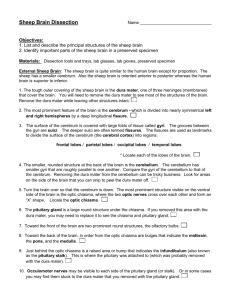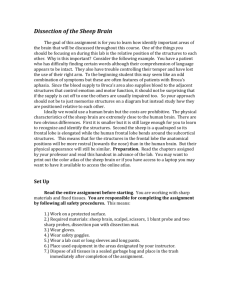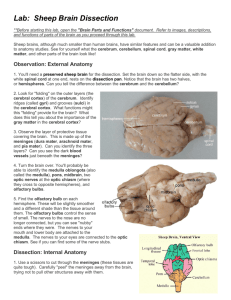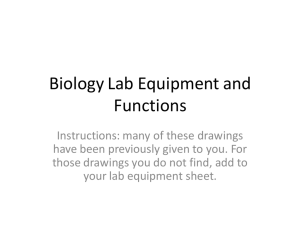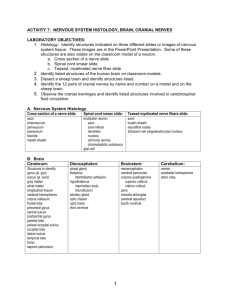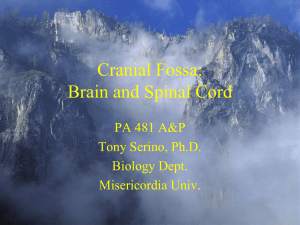DISSECTION EXERCISE: SHEEP BRAIN Introduction:
advertisement
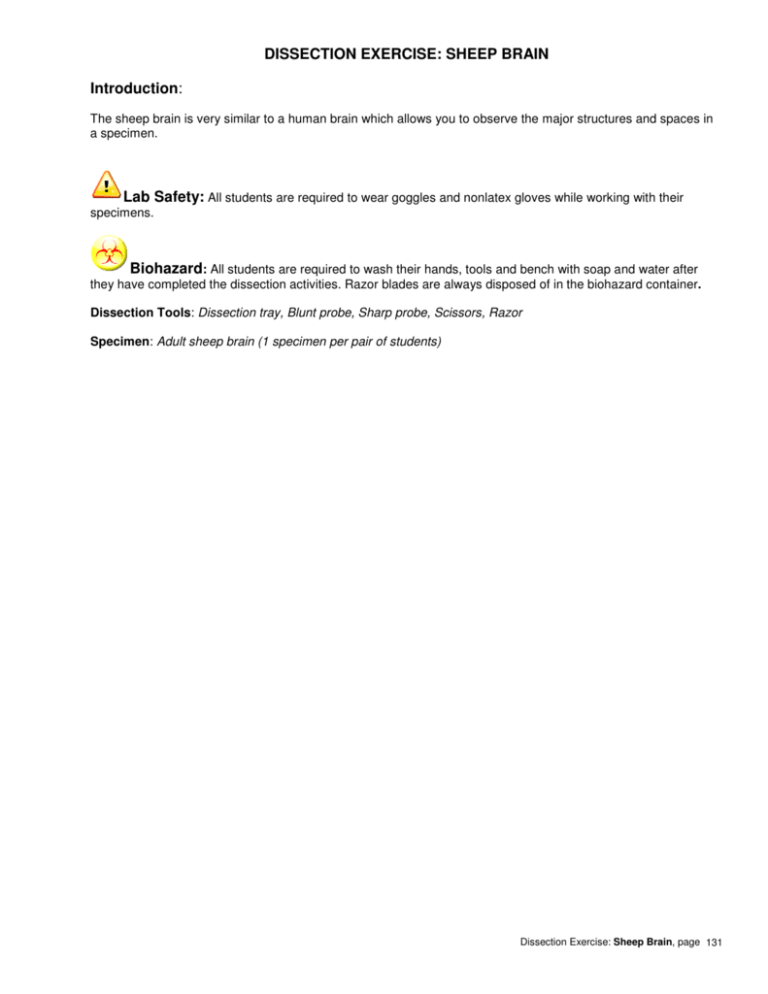
DISSECTION EXERCISE: SHEEP BRAIN Introduction: The sheep brain is very similar to a human brain which allows you to observe the major structures and spaces in a specimen. Lab Safety: All students are required to wear goggles and nonlatex gloves while working with their specimens. Biohazard: All students are required to wash their hands, tools and bench with soap and water after they have completed the dissection activities. Razor blades are always disposed of in the biohazard container. Dissection Tools: Dissection tray, Blunt probe, Sharp probe, Scissors, Razor Specimen: Adult sheep brain (1 specimen per pair of students) Dissection Exercise: Sheep Brain, page 131 Activity 1: External Anatomy of the Sheep Brain Observe the following structures on your sheep brain. Use the diagrams of the human brain, photos below and the photo album online to help you in those identifications. Procedure: 1. Assemble all of the dissection tools, put on your goggles and gloves and use your dissection tray to transport one specimen to your bench. 2. Identify the external anatomy on the superior surface of your specimen (Use your diagram of the human brain to aid you in your identifications): a. Dura mater (if applicable) is a fibrous connective tissue, outermost meninges, that covers the surface of the brain. b. Pia mater is a thin delicate membrane, innermost meninges, that covers the surface of the brain. c. The largest portion of the brain is the cerebrum and/or right and left cerebral hemispheres. It has grooves, cerebral sulci, and bumps, cerebral gyri, that increase the surface area of the cerebral cortex. d. The longitudinal fissure separates the two cerebral hemispheres. e. The dorsal portion of the brain is the cerebellum. f. The nervous tissue that is seen on the surface is largely gray matter. Dissection Exercise: Sheep Brain, page 132 3. Identify the external structures on the inferior surface of your specimen: a. Cranial nerve I or Olfactory Bulb carries sensory information regarding smell to the cerebral cortex. b. Cranial nerve I or Optic nerve carries sensory information regarding vision to the cerebral cortex. The optic chiasma is where the axons from each (right and left) cranial nerve separate and take information regarding the images seen with one eye to both cerebral hemispheres. c. The pituitary gland is part of the endocrine system, however, axons from the hypothalamus makeup the structure of the posterior pituitary gland. These axons connect, or form a stalk called the infundibulum, that holds the pituitary gland to the inferior surface of the brain. d. The Trigeminal Nerve is a large nerve located located on either side of the pituitary gland (right and left trigeminal nerves). e. Two parts of the brainstem may be visible beneath the dura mater on the inferior surface, the pons dorsal to the pituitary gland, followed by the medulla oblongata which continues on as the spinal cord. f. In some cases, you may see the arrangement of the gray and white matter in the cross section of the terminal end of the spinal cord of your specimen. 4. Record your observations in your lab notebook. Dissection Exercise: Sheep Brain, page 133 Activity 2: Sheep Brain Dissection In this activity you will be removing the dura mater, if applicable, cutting your specimen into equal right and left halves in order to identify the structures and spaces visible on the midsagittal section of the specimen. Procedure: 1. Remove the dura mater (if applicable) from your specimen. You should leave a strip of dura mater along the midline of the inferior surface of the brain—preserving the optic nerves, optic chiasma and pituitary gland. a. Remove from both cerebral hemispheres. Use your scissors, blunt blade next to the tissue, and cut the dura mater in a circular fashion around one cerebral hemisphere at a time. You will leave a ‘T’ of dura mater within the longitudinal fissure and between the cerebral hemispheres and cerebellum when you are finished. b. Remove the dura mater from the cerebellum by cutting a circle around the cerebellum. c. 2. Identify the pia mater after dura mater removal. Use your sharp probe to lift up the very thin membrane covering the surface of the brain. Use the razor or dissection knife to slice through (no sawing) through the midline of the brain producing a midsagittal cut. Begin your midline cut with the inferior surface and ending it by cutting through the longitudinal fissure. 3. Each lab partner may use one-half of the specimen to identify the internal structures and spaces of the specimen: a. The corpus callosum consists of tracts of white matter connecting the right and left cerebral hemispheres. Within the corpus callosum is a space, the lateral ventricle (one located on each side) which contains cerebrospinal fluid produced by a capillary bed called the choroid plexus. You should also observe the outer cerebral cortex is obviously composed of gray matter as compared to the white matter of the corpus callosum. rd b. The 3 ventricle is the space between the corpus callosum and the thalamus. Together the thalaum and hypothalamus form the diencephalon. Inferior to the thalamus is the hypothalamus, follow the infundibulum to the pituitary gland. Notice how thin and delicate the axons of the hypothalamus are as it connects these two structures. c. Dorsal to the hypothalamus are the three different parts of the Brainstem: the midbrain, pons and medulla oblongata which continues on as the spinal cord. d. The cerebellum has distinct areas of gray matter and white matter. The outer portion is gray and the inner white matter has a characteristic ‘tree-like’ pattern called the arbor vitae. 4. Complete the analysis questions in your lab notebook. Dissection Exercise: Sheep Brain, page 134
